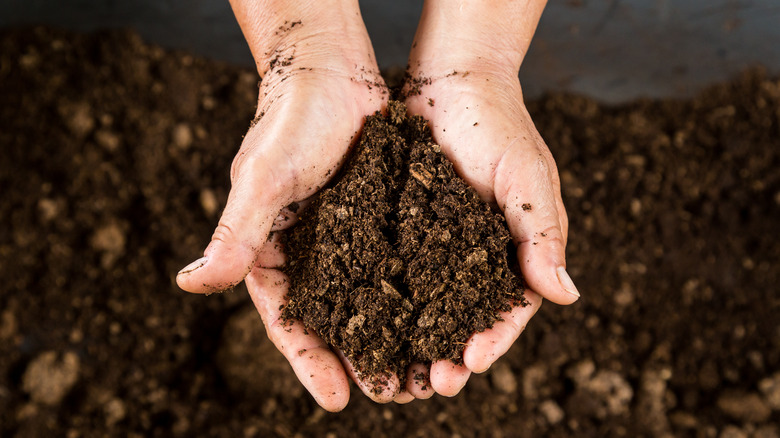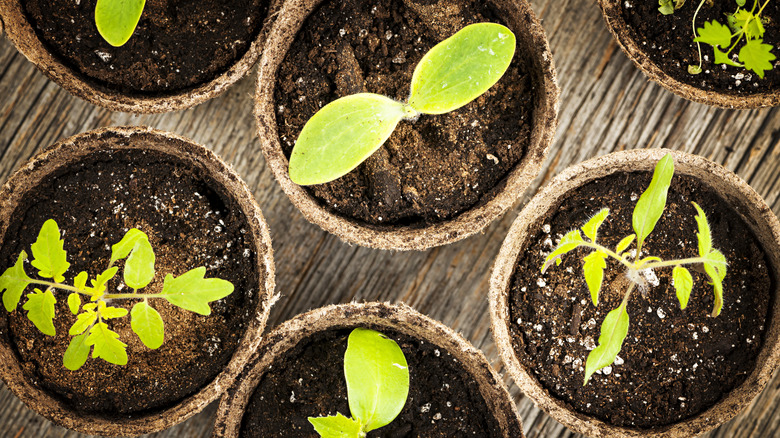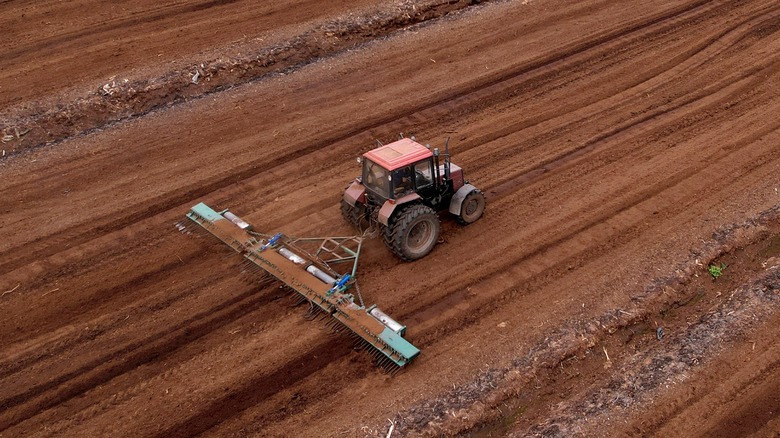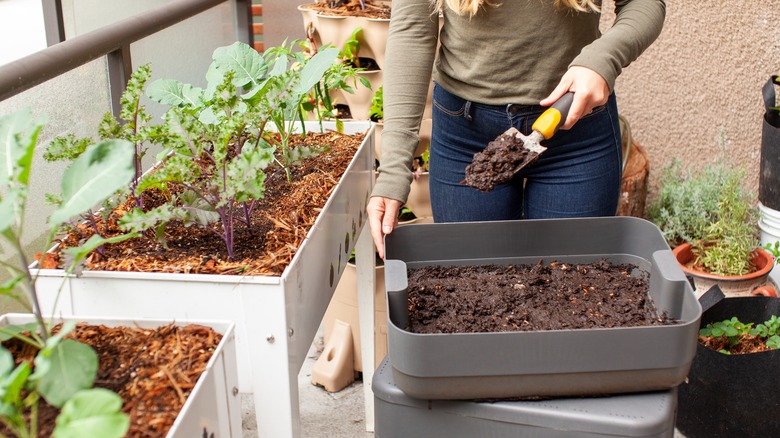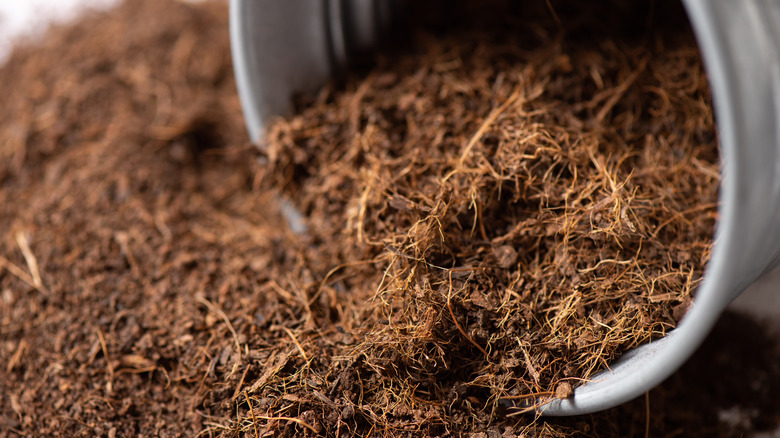What Is Peat Moss And How Do You Use It In Your Garden?
If you're an avid gardener, you've probably used peat moss, or at least heard of it. Peat moss forms in bogs over thousands of years, as living plants — most commonly, sphagnum moss — decompose and the resulting debris slowly accumulates to form compact layers. There is occasionally some confusion between peat moss and sphagnum moss, according to Trees.com. The key distinction is that sphagnum moss is living; once decomposed, it becomes peat moss.
Most commonly found in the northern hemisphere, the majority of peat moss sold in the United States comes from Canada, per Trees.com. However, Canada comes second to Russia as the country that grows the most peat moss in the world. Peat moss has a variety of benefits, such as starting seeds, amending soil, and even adjusting the soil's pH levels. It's not recommended as a soil substitute, however, as peat moss alone is likely to compress the roots and choke your plant. It works best when mixed into the soil to improve moisture retention and aeration. Being as versatile and widely used as it is, it can be found in any gardening center today.
How to use peat moss
As previously mentioned, peat moss is great for planting, however, it is not often used as a standalone product, as it shouldn't be. Peat moss alone can compress your plant's roots, and it lacks the necessary nutrients that plants need to survive. This is why it is typically mixed with another ingredient in a 2:1 ratio; two parts growing medium, one-part peat moss. For growing medium, you can use perlite, vermiculite, or just regular soil.
That being said, peat moss is perfect for acid-loving plants, as it has a low pH level. That means fruits and vegetables, in particular, thrive in peat moss, as well as flowers such as camellias and azaleas. An additional benefit for vegetable gardens is peats' ability to improve drainage and ensure the soil does not get too wet or too dry. Rich in carbon, peat moss is also good for breaking down compost piles. It's also commonly used for seed starting, as it is sterile and thus prevents the development of bacteria and fungi that can harm young plants. The aeration peat moss provides also aids in seed germination. However, it is most commonly used and known as a soil amendment. For heavy soils, peat moss can help soften the ground and improve drainage. For lighter soils, it helps retain moisture and nutrients for the plants, according to Plants Spark Joy. In any case, peat moss can improve any type of soil!
Pros and cons of using peat moss
In terms of benefits, peat moss has quite a few that we've already mentioned. From improving drainage and aeration to providing a sterile environment for sprouting seeds, peat moss is incredibly versatile and you're bound to find at least one way to use it in your garden. According to The Spruce, it's also relatively inexpensive, especially when compared to other soil amendments, and is readily available in stores throughout the U.S.
On the other hand, peat moss does have some drawbacks as well. It's important to remember that peat moss contains no nutrients whatsoever — in fact, this is a primary reason why it cannot be used alone. Plants require the presence of healthy microbes that are found in soil, but as a sterile medium, peat lacks these essentials. Without them, your plants will not grow as big or healthy as they should. Peat moss is also acidic which is great news for plants that need a low pH level, but it can harm plants that require more neutral soil. In these cases, you'll want to monitor the pH level and probably add garden lime if you are growing a plant that needs a higher pH.
Another significant drawback is that peat moss is not at all considered environmentally friendly, as it is a non-renewable resource that takes thousands of years to form. Additionally, according to the IUCN, the harvesting process of peat moss emits a lot of carbon into the air. In fact, it emits more than all other vegetation types in the world combined.
Different types of peat moss
Depending on its depth, peat moss has different degrees of decomposition. These are known as grades and are calculated using the Von Post scale, which ranks them from H1 to H10, according to Pro-Mix. The peat moss near the surface (H2) is blonde in color and fibrous in texture, whereas peat from deeper sections (H5) is more humid, dark brown, and less fibrous. For commercial use, peat is categorized based on other properties such as color and particle size.
What is most often sold in the United States is peat moss in the range of H1 to H5. Once harvested, it is often blended with other materials to reach certain physical properties in order to be sold. For example, H1 peat moss used in containers can shrink over time, and H5 peat moss is good for gardening but is too heavy if not mixed with a lighter growing medium. Black peat moss is very fine, used often for growing mushrooms that prefer the denser humus. Fine peat moss is most appropriate for starting seeds. Course peat moss is blonde, light, and fluffy, perfect for maximizing aeration and maintaining appropriate water levels in containers.
Peat moss alternatives
Although peat moss undoubtedly has beneficial qualities, it also has some drawbacks, most notably in terms of its environmental impact. So, if those cons are just a bit too much for you to leap into using peat moss, there are other materials you can use. For starters, compost is a great option, as it offers similar benefits to peat moss, but is completely renewable, per Epic Gardening. It also has other advantages that peat moss does not, such as a more neutral pH, the inclusion of microorganisms, and the fact that it is rich in nutrients. However, compost may contain weed seeds, harmful pathogens, and will not retain water as well as peat moss.
Other alternatives include coco coir, which is derived from the outer husk of the coconut. This material is coarser than most peat moss, making it better than aeration. Fast-growing coconuts are also a more sustainable resource, although coconut coir tends to be more expensive than peat moss. Pine bark or wood fiber can also be used as a substitute for peat moss, as it helps keep the soil moist and prevents weeds.
